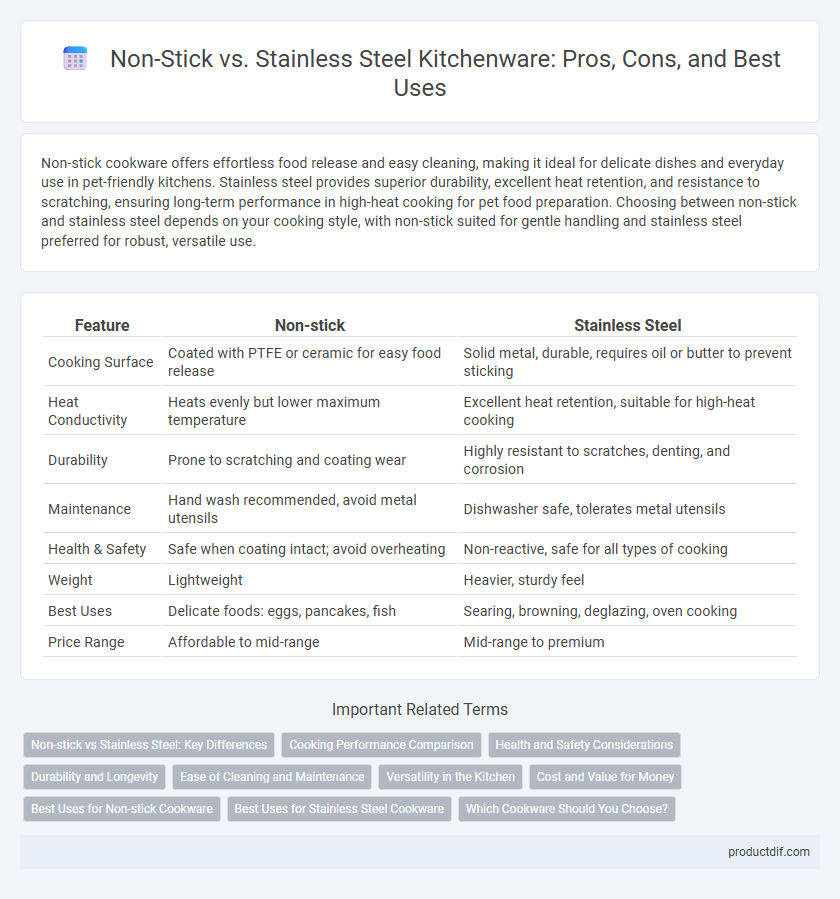Non-stick cookware offers effortless food release and easy cleaning, making it ideal for delicate dishes and everyday use in pet-friendly kitchens. Stainless steel provides superior durability, excellent heat retention, and resistance to scratching, ensuring long-term performance in high-heat cooking for pet food preparation. Choosing between non-stick and stainless steel depends on your cooking style, with non-stick suited for gentle handling and stainless steel preferred for robust, versatile use.
Table of Comparison
| Feature | Non-stick | Stainless Steel |
|---|---|---|
| Cooking Surface | Coated with PTFE or ceramic for easy food release | Solid metal, durable, requires oil or butter to prevent sticking |
| Heat Conductivity | Heats evenly but lower maximum temperature | Excellent heat retention, suitable for high-heat cooking |
| Durability | Prone to scratching and coating wear | Highly resistant to scratches, denting, and corrosion |
| Maintenance | Hand wash recommended, avoid metal utensils | Dishwasher safe, tolerates metal utensils |
| Health & Safety | Safe when coating intact; avoid overheating | Non-reactive, safe for all types of cooking |
| Weight | Lightweight | Heavier, sturdy feel |
| Best Uses | Delicate foods: eggs, pancakes, fish | Searing, browning, deglazing, oven cooking |
| Price Range | Affordable to mid-range | Mid-range to premium |
Non-stick vs Stainless Steel: Key Differences
Non-stick cookware features a coating that prevents food from sticking, making it ideal for cooking delicate items with minimal oil and easy cleanup, while stainless steel offers superior durability and high heat tolerance, allowing for better browning and deglazing. Non-stick pans typically have a shorter lifespan and require gentle care to avoid scratching, whereas stainless steel pans can withstand metal utensils and dishwasher use without damage. Choosing between non-stick and stainless steel depends on cooking style, with non-stick preferred for low-fat cooking and stainless steel favored for searing and versatile kitchen use.
Cooking Performance Comparison
Non-stick cookware excels in cooking delicate foods like eggs and pancakes with minimal oil, ensuring easy release and quick cleanup. Stainless steel offers superior heat retention and even cooking, making it ideal for searing, browning, and deglazing, which enhances flavor development. Both materials impact cooking performance, with non-stick providing convenience and stainless steel delivering durability and versatility.
Health and Safety Considerations
Non-stick cookware typically features a PTFE coating that can emit harmful fumes if overheated above 500degF, posing health risks like polymer fume fever, while stainless steel is inert and doesn't release toxins during cooking. Stainless steel is favored for its resistance to scratching and corrosion, ensuring long-term safety by preventing metal leaching, especially with acidic foods. Choosing stainless steel reduces exposure to potentially hazardous chemicals, making it a safer option for health-conscious kitchen use.
Durability and Longevity
Non-stick cookware offers convenience with easy food release but typically has a shorter lifespan due to surface coating wear and potential peeling over time. Stainless steel kitchenware boasts superior durability, resisting scratches, dents, and high heat without degrading, making it a long-lasting choice for frequent cooking. Investing in stainless steel ensures consistent performance and longevity, especially for heavy-duty culinary tasks.
Ease of Cleaning and Maintenance
Non-stick cookware offers superior ease of cleaning due to its smooth, coated surface that prevents food from sticking, requiring only gentle wiping or hand washing to maintain. Stainless steel pans, while more durable, demand thorough scrubbing and sometimes specialized cleaners to remove food residues and prevent discoloration. Regular seasoning is unnecessary for stainless steel but essential for non-stick to preserve its non-stick properties and extend lifespan.
Versatility in the Kitchen
Non-stick cookware excels in preparing delicate foods like eggs and pancakes due to its easy release, while stainless steel offers superior versatility for searing, browning, and deglazing at high temperatures. Stainless steel pans withstand metal utensils and high heat, making them ideal for a wider range of cooking techniques including sauteing, frying, and oven use. Non-stick pans require gentler handling and lower heat but simplify cooking and cleanup for specific tasks, balancing convenience with limited durability.
Cost and Value for Money
Non-stick cookware generally offers a lower upfront cost and is ideal for budget-conscious buyers seeking easy food release and quick cleaning. Stainless steel cookware tends to have a higher initial price but provides greater durability, longevity, and versatility, delivering better value for money over time. Investing in stainless steel often results in cost savings due to its resistance to warping, scratching, and the need for frequent replacements.
Best Uses for Non-stick Cookware
Non-stick cookware excels at cooking delicate foods like eggs, pancakes, and fish due to its smooth surface that prevents sticking and allows for easy flipping and cleanup. It requires less oil or butter, making it ideal for low-fat, healthy cooking and fast, convenient meal preparation. Non-stick pans are best suited for gentle heat settings and quick-cooking tasks rather than high-temperature searing or browning.
Best Uses for Stainless Steel Cookware
Stainless steel cookware excels in high-heat cooking methods such as searing, sauteing, and deglazing due to its excellent heat retention and even heat distribution. It is ideal for browning meats, reducing sauces, and preparing acidic foods that can react with non-stick surfaces. Durable and resistant to scratches, stainless steel pans are preferred for tasks requiring metal utensils and frequent oven use.
Which Cookware Should You Choose?
Non-stick cookware offers excellent food release and easy cleaning, making it ideal for low-fat cooking and delicate foods like eggs and pancakes. Stainless steel cookware provides superior heat retention and browning capabilities, suitable for searing, deglazing, and high-heat cooking techniques. Choosing between non-stick and stainless steel depends on your cooking style, desired maintenance level, and the types of dishes you frequently prepare.
Non-stick vs Stainless steel Infographic

 productdif.com
productdif.com